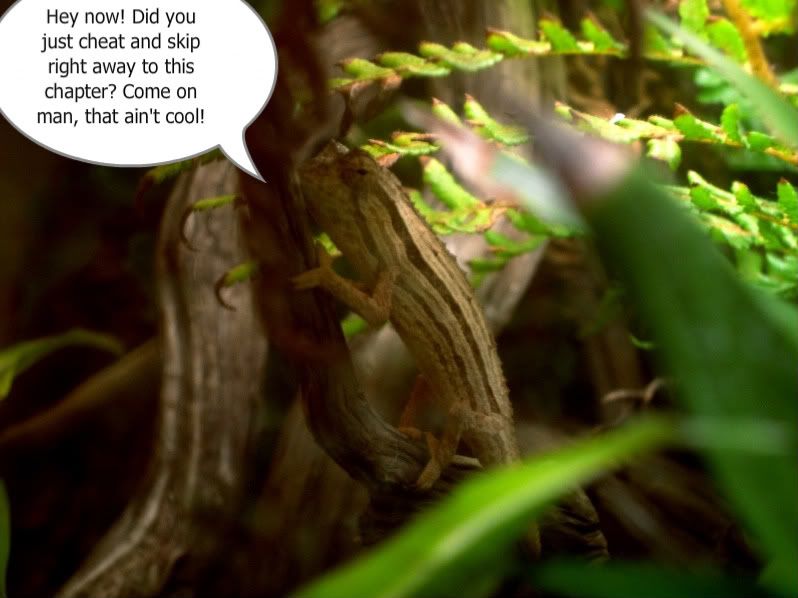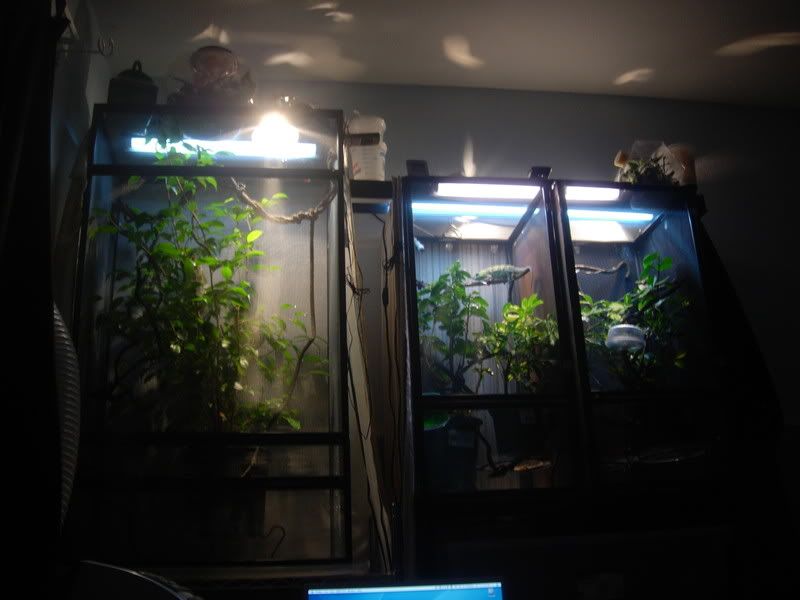Article was posted on June 16, 2009 12:25 PM
Chameleons are susceptible to illnesses brought on by a host of bacteria, viruses, and other pathogens. Diseases spread most rapidly in unsanitary and crowded conditions and most easily affect weakened or stressed animals. Such conditions are almost inevitable in recently imported chameleons and all too common in many breeding operations. It is, therefore, important to protect animals already in your care from infection by any new arrivals as well to protect the new arrival itself. This article provides some “best practices” when bringing home a new chameleon. Newly acquired chameleons should be treated as if all are infected until proven otherwise. Even captive bred animals from the most respected sources can carry infections that were unknown to the breeder. A stressed animal is, almost by definition, immunologically compromised and organisms that had been benign can become problematic after the stress of shipping and adaptation to a new environment.
Planning for the new arrival:
Planning for the new arrival is a crucial step. Conduct research into the needs of the species you will be acquiring and have the setup ready and tested before the animal arrives.
- Choose a location for the new arrival: A good location is key to a successful transition. The new arrival should be physically isolated from any other animals, preferably in a separate room. This will help to protect both new and old animals from cross contamination. Just as in any setup, the cage should be at a comfortable height and be placed in a low traffic location. Giving the chameleon a view from above and minimizing disturbance from both animals (including cats, dogs, etc.) and humans will help to reduce its stress.
- Husbandry: Lighting, temperature and watering should be in place and appropriate to the species. Plants should be clean and repotted. You should feel comfortable that the environment is functional and sanitary. Err on the side of providing excessive hydration. New animals are often somewhat dehydrated.
Arrival
- Handling the new Arrival: When handling the newly acquired chameleon it is important to wash your hands before and after handling any other animals. Ideally, one should wear latex or non latex examination gloves and change them between animals. Treat everything as if it is contaminated.
- Basic Physical Examination: A visual examination of the animal should have been made before it was acquired but it is important to re-examine the animal to make sure nothing has happened in transit or that something was not missed by you or the supplier. An examination of the eyes, feet, skin, and the inside and corners of the mouth should be done. Doing this before the chameleon is placed in the enclosure prevents you from having to remove it again while it is becoming accustomed to its new home. Again, the goal here is to limit stress. Weigh the Chameleon. An accurate weight will be a good starting point to judge the progress and the health of the chameleon.
- Introduction to the new home: After the examination it is now time to introduce the chameleon to its new home. Once the chameleon is in the enclosure it is best to “leave it alone.” Avoid holding or excessive viewing of the chameleon. It is best to limit activities to cleaning and watering. Observation and examination can be done at those times. I do not regularly handle new arrivals until they have had about 3 weeks to acclimate. Even then, handling should be infrequent, done only when necessary.
Diagnoses and Treatment
- Vet visit: Make an appointment with a reptile vet as soon as possible after acquiring your chameleon. It is important to have the new chameleon examined by a professional and have tests done to determine if there is anything that needs to be treated. A fecal examination should be done. In the event something is found, a course of treatment will be prescribed by the vet and should be followed exactly as outlined. After treatment, a follow up appointment will be needed and another fecal examination performed to determine if further treatment is needed. It is not uncommon for an initial fecal exam to be negative and then be positive a week or two later. So plan on doing at least two such exams regardless of the outcome of the initial exam. A list of qualified reptile veterinarians in your area can be found at the web site of the Association of Reptile and Amphibian Veterinarians at www.arav.org
- Screening for common parasites:
- Fecal Examination – Fecal examinations are primarily performed to detect microscopic gastrointestinal parasites. Common parasites found in chameleons and most commonly in wild caught specimens include, Intestinal protozoans (e.g., Coccidia), nematodes (pinworms, roundworms, lungworms), and cestodes (tape worms). In order to perform a fecal examination, a fresh fecal sample needs to be collected. Pick up a sample after the chameleon has recently eliminated and store it in a sealed plastic baggie. Fresh samples will give the most information and help in an accurate diagnoses. A wise practice is to have fecal examinations performed on all animals, even assumedly healthy animals, every 6 months to 12 months.
- Blood tests – Various hemoparasites reside in the blood stream may only be detectable by a blood test. Drawing blood in a chameleon is always highly stressful and this is especially true in the smaller species. Allow your veterinarian to decide on the appropriateness of doing blood work.
- Visual inspection for subcutaneous (filarial) worms – These parasites are often visible under the skin. Your veterinarian can sometimes surgically remove them.
- Hand hygiene: Hand sanitation has been cited as the most important tool in reducing the transmission of infectious agents. Using anti-microbial soap with hot water or one of the alcohol based products is recommended. For more information and detailed guidelines visit http://www.cdc.gov/mmwr/preview/mmwrhtml/rr5116a1.htm
- Cleaning: Know the difference between cleaning and disinfecting. In most cases, cleaning with soap and water is adequate for routine maintenance and day to day sanitation. Regular maintenance should include the removal of waste, wiping the bottom of the cage, and keeping the basking site clean.
- Disinfecting: Disinfecting is needed when there is a significant likelihood of high concentrations of dangerous microorganisms and/or that an infection will be spread to others. Below are some of the common methods of disinfecting:
- Submerging tools, vines, branches and other items in boiling water for 30 minutes to an hour will kill most organisms.
- Rubbing alcohol will disinfect and sterilize equipment but some microbes may be unaffected. Rubbing alcohol is most often used to disinfect equipment like tweezers, forceps, and needles.
- Bleach is stronger than alcohol. It is typically used by diluting ½-1 cup of household bleach in one gallon of water. It can be used to disinfect equipment such as tweezers, forceps, cages and needles by wiping down the object or by submerging in the solution of diluted bleach.
- Miscellaneous chemicals have been developed for disinfecting and/or cleaning of reptile and bird cages. Many are effective but they should be used with caution. They are often corrosive and can cause damage to organic or inorganic materials.
- Steam cleaning is a safe alternative to chemical disinfectants. Steam is produced under high pressure through a nozzle and effectively kills many organisms.
- Latex or non-latex examination gloves) – Gloves provide protection for you and you chameleon when cleaning or performing examinations. This is key in preventing cross-contamination
- Hydrogen peroxide (7%-12%) is a disinfectant used to clean and disinfect equipment, cages, and other surfaces. Anything under 7% is not effective in killing Coccidia
- Bleach is an excellent disinfectant for equipment, cages, and other surfaces.
- Steam cleaner. This is a high pressure steamer that is a good alternative to chemicals that can damage organic material.
- Disposable towels are invaluable for wiping up messes for use as a disposal liner for cage bottoms.
Your Medicine Cabinet: items to have on hand
- Supplements. Phosphorus free Calcium Powder without Vitamin D3, Calcium Powder with vitamin D3, reptile multi vitamin.
- Syringes of different sizes. These are useful for the administration of medications, supplements, like calcium, for hand feeding, and for cleaning and sterilization, especially of tubing. (Syringes should not be used to administer oral supplements, medications or foods except to sick animals under the direction of a veterinarian.)
- Cotton Balls and Q-tips are useful for cleaning and for the application of creams and topical medications.
- Properly diluted Chlorhexidine Gluconate product. This is an ideal substance for the topical treatment for many common problems such as foot and temporal gland infections.
- Iodine can be an effective topical antiseptic agent although most veterinarians will recommend Chlorhexidine Gluconate.
- Liquid calcium is a supplement that can assist in recovery from and prevention of metabolic bone disease (MBD). It should be administered only under the direction of a veterinarian.
- K-Y jelly is a lubricant that is commonly used in the treatment of rectal and hemipenal prolapses to prevent drying out of the affected organ.
- Tweezers are ideal for handling and extracting small objects.
References:
Klingenberg, R. J. (1993) Understanding Reptile Parasites. 2nd Ed. , Advanced Vivarium Systems, Lakeside , CA .
Mader, D. R. (1996) Reptile Medicine and Surgery 2nd Ed. W.B. Saunders, Philadelphia , PA.
Davidson, L. (1997). Chameleons Their Care and Breeding. Hancock House, Blaine , WA .
Center for Disease Control. Infection Control in Dental Settings http://www.cdc.gov/oralhealth/infectioncontrol/glossary.htm
Center for Disease Control. Guideline for Hand Hygiene in Health-Care Settings. http://www.cdc.gov/mmwr/preview/mmwrhtml/rr5116a1.htm







